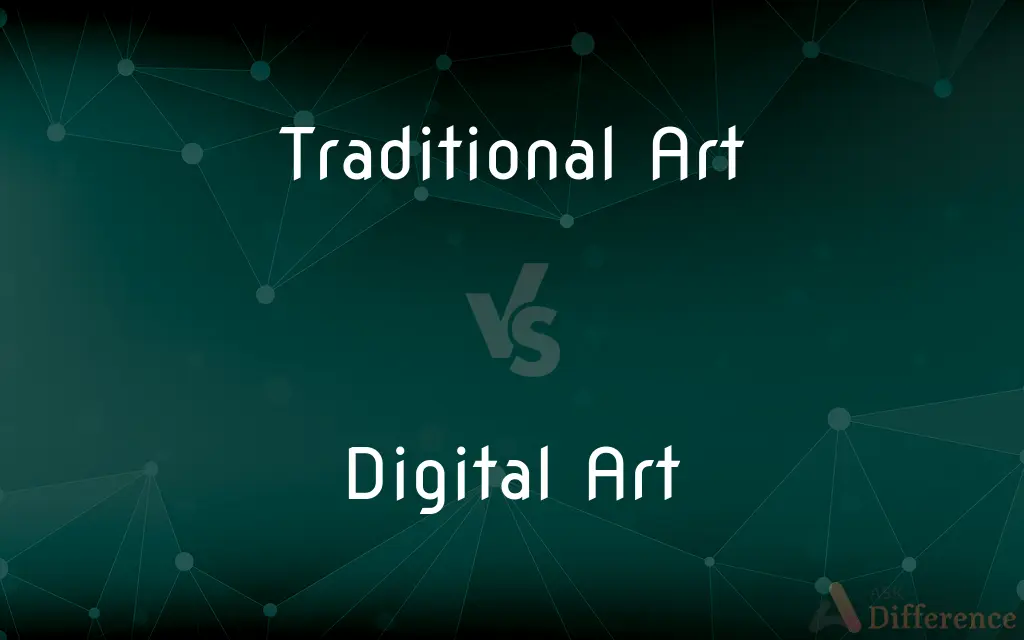Traditional Art vs. Digital Art — What's the Difference?
By Tayyaba Rehman — Published on November 15, 2023
Traditional Art uses tangible mediums like paint & canvas, while Digital Art is created using electronic devices & software.

Difference Between Traditional Art and Digital Art
Table of Contents
ADVERTISEMENT
Key Differences
Traditional Art encompasses art forms that use physical materials such as paint, charcoal, and canvas. Digital Art, in contrast, is crafted using electronic devices, specifically computers, tablets, and specialized software.
With Traditional Art, artists engage directly with their materials, feeling the texture of the canvas, or the drag of a brush. In the realm of Digital Art, the artist typically interacts with a stylus and screen, navigating various software tools to produce their vision.
Traditional Art, once completed, is a singular, tangible piece, often requiring a physical space for display. Conversely, Digital Art is inherently replicable, easily shared and distributed digitally, and can be showcased virtually or printed out.
In terms of corrections and modifications, Traditional Art can be challenging to alter without leaving traces of change. Digital Art offers the advantage of layers, undo buttons, and multiple versions, allowing for more flexibility in revisions.
Lastly, Traditional Art often necessitates a variety of tools and materials for different techniques, potentially requiring significant storage and organization. Digital Art centralizes the tools within software, enabling vast techniques with just a device and the right program.
ADVERTISEMENT
Comparison Chart
Medium
Physical materials (e.g., paint, canvas)
Electronic devices & software
Tangibility
Tangible, physical pieces
Intangible; can be printed or displayed digitally
Alterations
Hard to modify without traces
Easy modifications with undo & layers
Distribution
Requires physical replication or display
Easily shared & replicated digitally
Tools & Space Requirement
Multiple tools; may need significant space & organization
Centralized in software; requires minimal space
Compare with Definitions
Traditional Art
Art created using physical materials.
Oil paintings in a gallery are examples of Traditional Art.
Digital Art
Artworks birthed in a virtual environment.
The digital painter used a tablet to create that stunning Digital Art piece.
Traditional Art
Artworks that don't involve digital means.
The charcoal sketches are a pure form of Traditional Art.
Digital Art
Visual creations easily replicable and distributable.
The artist's Digital Art was shared across social media platforms.
Traditional Art
Craftsmanship employing age-old techniques.
The potter's hand-crafted bowls are a form of Traditional Art.
Digital Art
Art that merges technology with artistic vision.
The 3D-rendered sculptures represent the future of Digital Art.
Traditional Art
Expressions that involve direct interaction with materials.
The sculptor's marble statues are a testament to Traditional Art.
Digital Art
Art produced using electronic devices.
The graphic designer's poster is a piece of Digital Art.
Traditional Art
Creations that yield tangible, unique pieces.
The watercolor landscapes, each distinct, showcase the beauty of Traditional Art.
Digital Art
Creative expressions crafted with software tools.
The animated film is a brilliant example of Digital Art.
Common Curiosities
How does Digital Art differ from Traditional Art?
Digital Art is created using electronic devices and software, whereas Traditional Art uses physical materials.
Can you print Digital Art to make it tangible?
Absolutely! Digital Art can be printed onto various materials to create physical pieces.
Is Traditional Art more valuable than Digital Art?
Value is subjective. Some might value the tangibility of Traditional Art, while others appreciate the versatility of Digital Art.
Which is more environmentally friendly?
While Digital Art uses electronic energy, it avoids physical waste. Traditional Art might involve material waste. Both have impacts, just in different ways.
Can Digital Art replicate the look of Traditional Art?
Yes, with advanced software, Digital Art can emulate the appearance of many Traditional Art techniques.
How do artists store Traditional Art?
Traditional Art is stored in physical spaces, like studios or galleries, and may require special conditions.
Can Digital Art be sold like Traditional Art?
Yes, Digital Art can be sold, often as digital prints, licenses, or even as unique digital tokens (like NFTs).
How long has Digital Art been around?
Digital Art emerged with the advent of computers in the late 20th century and has evolved since.
Do universities teach Digital Art?
Yes, many institutions offer courses in Digital Art and related digital media fields.
What is Traditional Art?
Traditional Art uses physical mediums like paint, canvas, or charcoal to create tangible artworks.
Do you need expensive tools for Traditional Art?
Costs vary. While some Traditional Art forms require expensive materials, others can be more affordable.
Which offers more flexibility in terms of corrections?
Digital Art offers more flexibility for revisions, thanks to features like layers and the "undo" command.
Can beginners start with Digital Art?
Definitely! Many find Digital Art accessible due to software features like "undo."
Are there hybrid forms combining both?
Yes, some artists create Traditional Art, then enhance or modify it digitally.
Is Traditional Art fading due to the rise of Digital Art?
While Digital Art is gaining popularity, Traditional Art continues to hold its charm and significance.
Share Your Discovery

Previous Comparison
Emporio Armani vs. Armani Exchange
Next Comparison
Lean Protein vs. Whey ProteinAuthor Spotlight
Written by
Tayyaba RehmanTayyaba Rehman is a distinguished writer, currently serving as a primary contributor to askdifference.com. As a researcher in semantics and etymology, Tayyaba's passion for the complexity of languages and their distinctions has found a perfect home on the platform. Tayyaba delves into the intricacies of language, distinguishing between commonly confused words and phrases, thereby providing clarity for readers worldwide.
















































